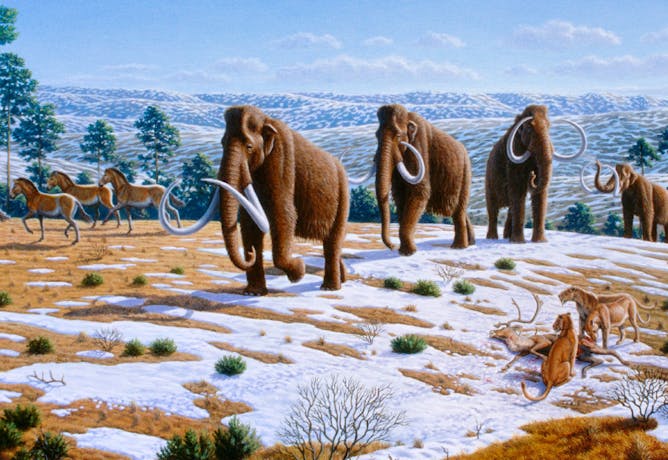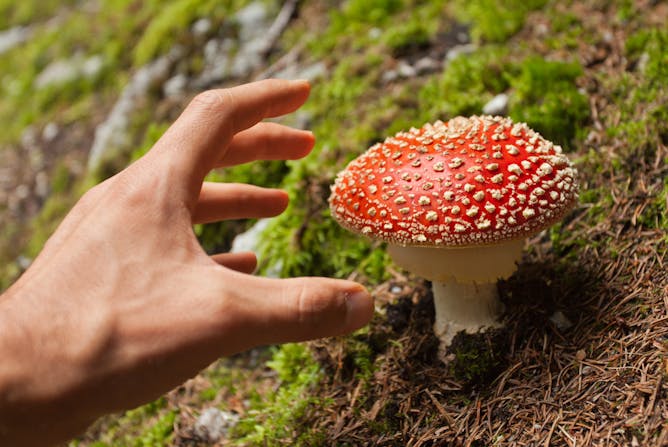|
|
|
|
University of South Carolina archaeologist Christopher R. Moore used modern forensic techniques to shed light on one of the most enduring questions about prehistoric North America: Were ice age humans responsible for the extinction of large animals, such as mammoths and giant bears? Moore describes his recently published study that examined 120 Clovis spear points and tools and found traces of blood proteins of some animals that lived 13,000 years ago. The research doesn’t provide a definitive answer on whether people, changes in the climate or other factors caused their demise, but “it proves that these animals were present in the Carolinas, and they were hunted or scavenged by early
Paleo-Americans,” he writes.
Last fall, editors at The Conversation developed a new article type known as Uncommon Courses, which highlights unusual classes taught by our academic writers. The latest installment in this occasional series was written by Western Illinois University anthropology professor Heather McIlvaine-Newsad, who developed a class called “From Magic Mushrooms to Big Pharma” that delves into nature-based medicine use and associated social issues. Her article touches on a range
of traditional medicines, including naturally occurring psychedelics and substances such as turmeric and ginger that have been used to treat inflammation.
Other stories our editors uncovered this week include a piece describing expected disruptions from El Niño this year, a look at how colonialism influences plant collections and biodiversity research and a study examining the
factors behind why Americans have higher excess death rates than similar high-income countries.
Also in this week’s science news:
If there’s a subject you’d like our team of science editors to investigate, please respond to this email.
[Sign up here for our Understanding AI series – four emails delivered over the course of a week.]
|

|
Martin LaMonica
Director of Editorial Projects and Newsletters
|
|

Animals that shared the landscape with humans disappeared as the ice age ended.
Mauricio Antón/Wikimedia Commons
Christopher R. Moore, University of South Carolina
A forensic technique more often used at modern crime scenes identified blood residue from large extinct animals on spearpoints and stone tools used by people who lived in the Carolinas millennia ago.
|

People for millennia have used what grows around them as medicine.
LorenzoT81/iStock via Getty Images Plus
Heather McIlvaine-Newsad, Western Illinois University
An anthropology course explores how peoples and cultures around the world use nature-based medicines to heal.
|

For Drosophila melanogaster, their senses have a significant effect on how quickly they age.
nico_blue/E+ via Getty Images
Christi Gendron, University of Michigan
When fruit flies see other dead fruit flies, their life spans are cut short. Other species also undergo analogous physiological changes when seeing their dead.
|
|
|

Simone Peinkofer, Michigan State University
Returns are becoming a costly sustainability problem for retailers and the planet. A supply chain expert explains.
| |

Brendan H. O'Connor, Arizona State University
We humans like to think that our language is original, but we absorb large amounts of it from others and liberally repeat and remix what we hear – just as language AIs do.
|

Bob Leamon, University of Maryland, Baltimore County
The official forecast calls for a strong El Niño by winter, but other models suggest it might dip in and out. An atmospheric scientist explains.
| |

Lindsey Schier, USC Dornsife College of Letters, Arts and Sciences; Scott Kanoski, USC Dornsife College of Letters, Arts and Sciences
The WHO report concluded that habitual use of nonsugar sweeteners is linked to a modest increase in diabetes, hypertension and stroke. But the research it’s based on has limitations.
|

Drew Shindell, Duke University
So much pollution goes into the air today that even without wildfire smoke, 99% of the global population breathes unhealthy air.
| |

Jae A. Puckett, Michigan State University
The rainbow Pride flags flying this month obscure the ongoing legislative attacks threatening the health and well-being of transgender and nonbinary people and their families.
|
|
|
|
|
-
Patrick Heuveline, University of California, Los Angeles
New research shows that preventable deaths are increasing in the US at the same time that life expectancy keeps dropping.
-
Carlton Basmajian, Iowa State University
Maybe it was a nuclear war, devastating climate change, or a killer virus. But if something caused people to disappear, imagine what would happen afterward.
-
John Mauro, Penn State; Katelyn Kirchner, Penn State
Two glass researchers explain how glass is made, the unique properties of glass and how those properties have allowed it to be a useful material to humans for thousands of years.
-
Daniel Park, Purdue University
The colonial era profoundly shaped natural history museums and collections. Herbaria, which are scientists’ main source of plant specimens from around the world, are no exception.
|
|
|
| | |
| | |
| |
| |

|
| |
| |
| |
| |
| |
| |
|
|
|
